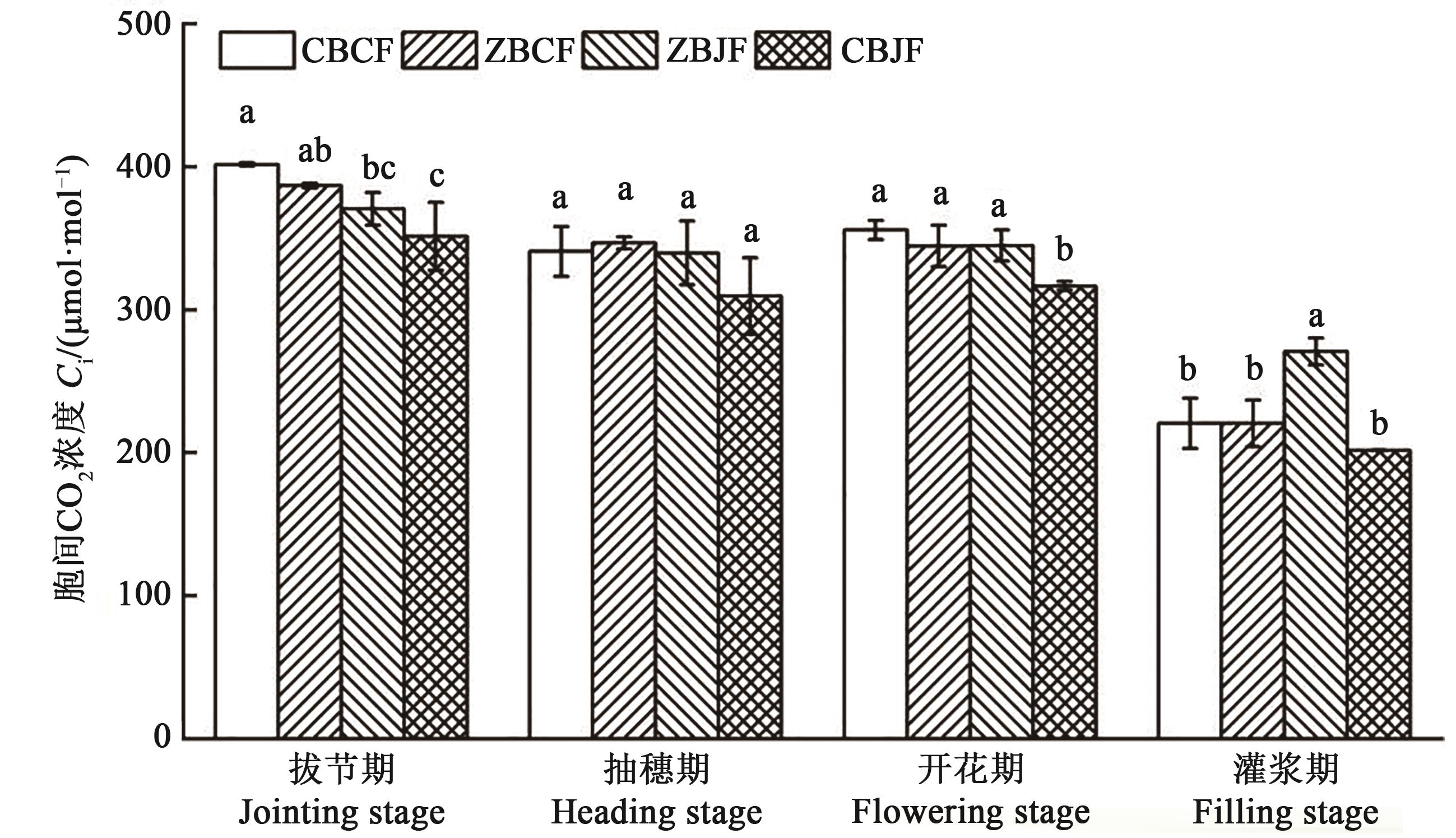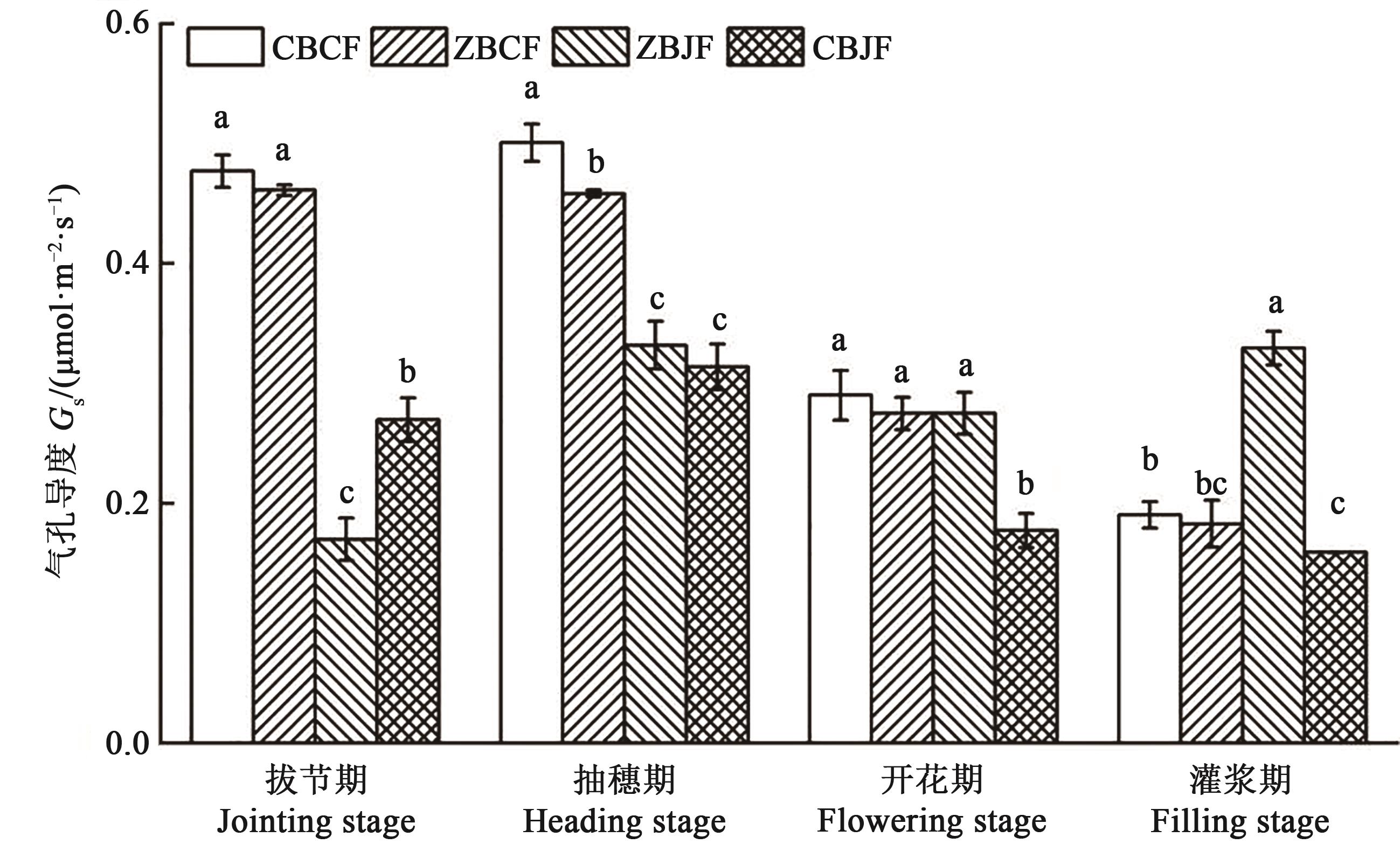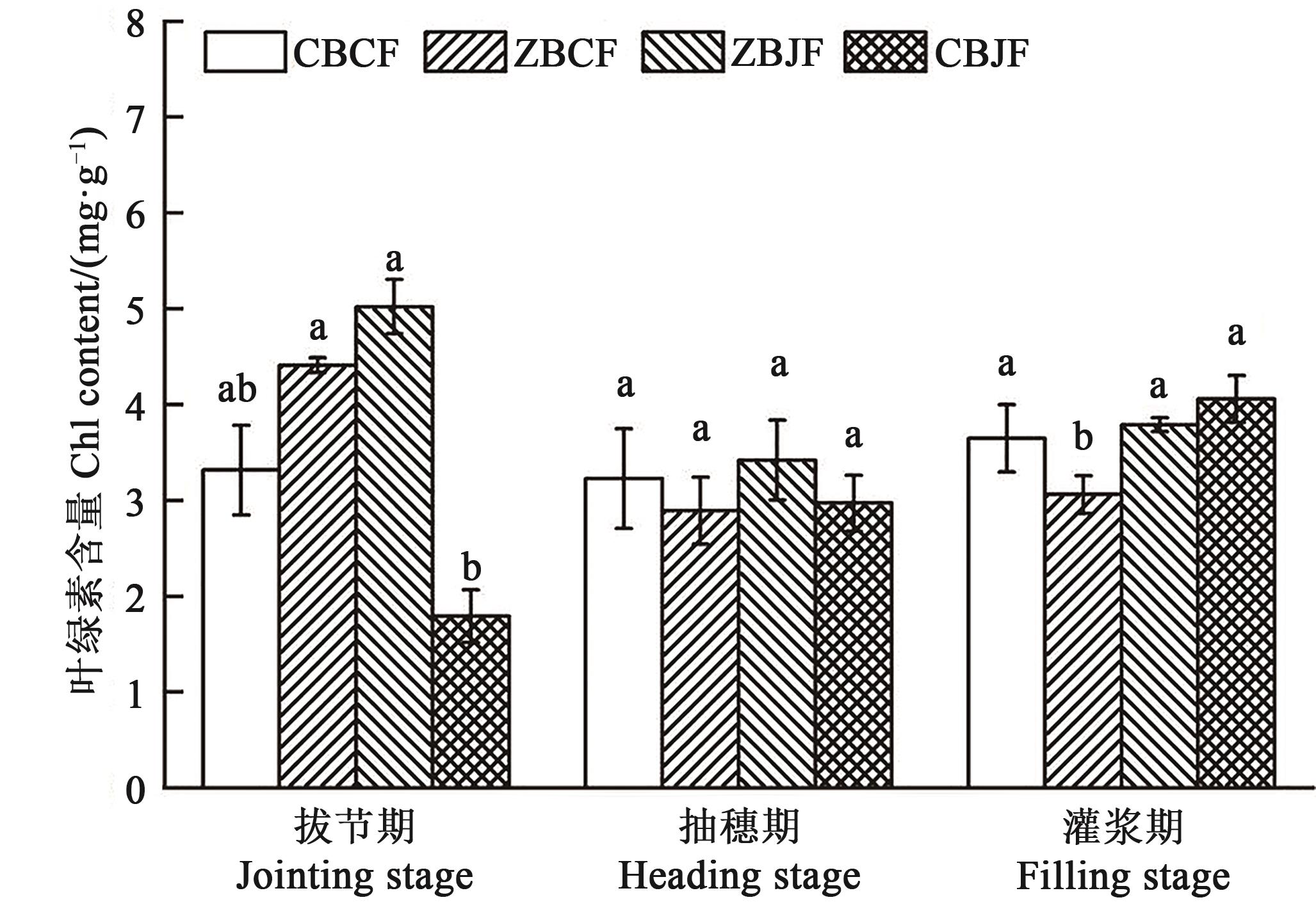




















中国农业科技导报 ›› 2023, Vol. 25 ›› Issue (5): 24-33.DOI: 10.13304/j.nykjdb.2022.0062
陈琛( ), 石柯, 朱长伟, 姜桂英(
), 石柯, 朱长伟, 姜桂英( ), 罗澜, 孟威威, 刘芳, 申凤敏, 刘世亮(
), 罗澜, 孟威威, 刘芳, 申凤敏, 刘世亮( )
)
收稿日期:2022-01-23
接受日期:2022-06-21
出版日期:2023-05-20
发布日期:2023-07-13
通讯作者:
姜桂英,刘世亮
作者简介:陈琛 E-mail: 1048778349@qq.com
基金资助:
Chen CHEN( ), Ke SHI, Changwei ZHU, Guiying JIANG(
), Ke SHI, Changwei ZHU, Guiying JIANG( ), Lan LUO, Weiwei MENG, Fang LIU, Fengmin SHEN, Shiliang LIU(
), Lan LUO, Weiwei MENG, Fang LIU, Fengmin SHEN, Shiliang LIU( )
)
Received:2022-01-23
Accepted:2022-06-21
Online:2023-05-20
Published:2023-07-13
Contact:
Guiying JIANG,Shiliang LIU
摘要:
为揭示种植密度和施氮水平对土壤氮素形态及小麦光合作用、产量的影响,在大田条件下,分别设置常规小麦播量+常规施氮量(CBCF)、小麦播量增加30%+常规施氮量(ZBCF)、小麦播量增加30%+氮量减施20%(ZBJF)、常规小麦播量+氮量减施20%(CBJF)共4个处理,其中小麦常规播量为232.5 kg·hm-2;常规施氮量为219 kg·hm-2。分析不同处理下小麦主要生育期的光合参数指标、成熟期小麦产量及土壤不同形态氮素含量。结果表明,①净光合速率和叶绿素含量随生育时期呈现先上升后下降趋势,其中CBJF处理提高了拔节期净光合速率;ZBJF处理在灌浆期的净光合速率最大,为20.53 μmol·m-2·s-1,同时增加了小麦拔节期叶绿素含量。②胞间CO2浓度和气孔导度均随生育时期呈现下降趋势,其中在拔节期常规施氮肥处理显著高于氮肥减施处理;灌浆期ZBJF处理胞间CO2浓度和气孔导度显著高于其他处理,分别为270.87 μmol·mol-1和0.33 μmol·m-2·s-1。③蒸腾速率随生育时期呈现先上升后下降趋势,在灌浆期ZBJF处理的蒸腾速率最高,为3.51 μmol·m-2·s-1。④ZBJF处理的穗粒数较CBJF处理增加12%,且减氮处理的小麦产量显著高于常规施氮处理。⑤相较于CBCF处理,氮肥减施处理降低了10—20 cm土层中全氮、碱解氮、铵态氮、硝态氮、可溶性有机氮和微生物量氮含量。本试验条件下,氮肥减施处理虽然减少了10—30 cm土壤有效态氮含量,但小麦生长和产量相较于常规施氮处理并未受到影响,从而提高了氮肥偏生产力,其中ZBJF处理提高了小麦灌浆期主要光合作用参数,并提高了小麦穗粒数、千粒重和产量。
中图分类号:
陈琛, 石柯, 朱长伟, 姜桂英, 罗澜, 孟威威, 刘芳, 申凤敏, 刘世亮. 种植密度和施氮量对豫北潮土区小麦光合特性和产量及土壤氮素的影响[J]. 中国农业科技导报, 2023, 25(5): 24-33.
Chen CHEN, Ke SHI, Changwei ZHU, Guiying JIANG, Lan LUO, Weiwei MENG, Fang LIU, Fengmin SHEN, Shiliang LIU. Effects of Planting Density and Nitrogen Application Rate on Wheat Photosynthetic Characteristics, Yield, and Soil Nitrogen Content in Fluvo-aquic Soil in Northern Henan Province[J]. Journal of Agricultural Science and Technology, 2023, 25(5): 24-33.
| 处理 Treatment | 小麦播量 Wheat seeding rate | N | P2O5 | K2O | |
|---|---|---|---|---|---|
| 基施 Base application | 追施 Topdressing | ||||
| CBCF | 232.50 | 150 | 69.0 | 120 | 120 |
| ZBCF | 302.25 | 150 | 69.0 | 120 | 120 |
| ZBJF | 302.25 | 120 | 55.2 | 120 | 120 |
| CBJF | 232.50 | 120 | 55.2 | 120 | 120 |
表1 各处理小麦播种量与施肥量 (kg·hm-2)
Table 1 Wheat seeding amount and fertilizer amount in each treatment
| 处理 Treatment | 小麦播量 Wheat seeding rate | N | P2O5 | K2O | |
|---|---|---|---|---|---|
| 基施 Base application | 追施 Topdressing | ||||
| CBCF | 232.50 | 150 | 69.0 | 120 | 120 |
| ZBCF | 302.25 | 150 | 69.0 | 120 | 120 |
| ZBJF | 302.25 | 120 | 55.2 | 120 | 120 |
| CBJF | 232.50 | 120 | 55.2 | 120 | 120 |

图1 不同处理不同生育时期净光合速率注:同一时期不同小写字母表示不同处理间在P<0.05水平差异显著。
Fig. 1 Net photosynthetic rates at different growth stages under different treatmentsNote: Different lowercase letters in same stage indicate significant differences between different treatments at P<0.05 level.

图2 不同处理不同生育时期胞间CO2浓度注:同一时期不同小写字母表示不同处理间在P<0.05水平差异显著。
Fig. 2 Intercellular CO2 concentrations at different growth stages under different treatmentsNote: Different lowercase letters in same stage indicate significant differences between different treatments at P<0.05 level.

图3 不同处理不同生育时期气孔导度注:同一时期不同小写字母表示不同处理间在P<0.05水平差异显著。
Fig. 3 Stomatal conductance at different growth stages under different treatmentsNote: Different lowercase letters in same stage indicate significant differences between different treatments at P<0.05 level.

图4 不同处理不同生育时期蒸腾速率注:同一时期不同小写字母表示不同处理间在P<0.05水平差异显著。
Fig. 4 Transpiration rates at different growth stages under different treatmentsNote: Different lowercase letters in same stage indicate significant differences between different treatments at P<0.05 level.

图5 不同处理不同生育时期叶绿素含量注:同一时期不同小写字母表示不同处理间在P<0.05水平差异显著。
Fig. 5 Chlorophyll content at different growth stages under different treatmentsNote: Different lowercase letters in same stage indicate significant differences between different treatments at P<0.05 level.
处理 Treatment | 成穗数 Spike number/ (×104·hm-2) | 穗粒数 Grains per spike | 千粒重 1 000-grain weight/g | 产量 Yield/(kg·hm-2) | 氮肥偏生产力 Nitrogen fertilizer partial productivity |
|---|---|---|---|---|---|
| CBCF | 538±7 c | 28±3 ab | 39.91±0.53 a | 5 296±317 b | 24.18±1.45 b |
| ZBCF | 554±11 c | 27±4 ab | 41.05±2.46 a | 5 535±295 b | 25.27±1.35 b |
| ZBJF | 573±7 b | 29±2 a | 41.28±1.31 a | 6 292±268 a | 35.91±1.53 a |
| CBJF | 619±4 a | 26±0 b | 40.09±1.00 a | 6 181±257 a | 35.28±1.46 a |
表2 不同处理小麦产量及其构成因素
Table 2 Wheat yield and its components under different treatments
处理 Treatment | 成穗数 Spike number/ (×104·hm-2) | 穗粒数 Grains per spike | 千粒重 1 000-grain weight/g | 产量 Yield/(kg·hm-2) | 氮肥偏生产力 Nitrogen fertilizer partial productivity |
|---|---|---|---|---|---|
| CBCF | 538±7 c | 28±3 ab | 39.91±0.53 a | 5 296±317 b | 24.18±1.45 b |
| ZBCF | 554±11 c | 27±4 ab | 41.05±2.46 a | 5 535±295 b | 25.27±1.35 b |
| ZBJF | 573±7 b | 29±2 a | 41.28±1.31 a | 6 292±268 a | 35.91±1.53 a |
| CBJF | 619±4 a | 26±0 b | 40.09±1.00 a | 6 181±257 a | 35.28±1.46 a |
土层 Soil layer/cm | 处理 Treatment | 全氮 Total nitrogen/(g·kg-1) | 碱解氮 Available nitrogen/ (mg·kg-1) | 硝态氮 Nitrate nitrogen/(mg·kg-1) | 铵态氮 Ammoniacal nitrogen/ (mg·kg-1) | 微生物量氮 Microbial biomass nitrogen/(mg·kg-1) | 可溶性有机氮 Dissolved organic nitrogen/(mg·kg-1) |
|---|---|---|---|---|---|---|---|
| 0—10 | CBCF | 0.97±0.04 a | 71.43±1.71 a | 39.63±2.18 a | 15.18±0.97 a | 61.28±7.83 a | 42.41±4.70 a |
| ZBCF | 0.84±0.06 b | 71.38±0.94 a | 35.29±2.90 b | 12.06±1.43 bc | 51.69±8.36 ab | 37.68±4.75 ab | |
| ZBJF | 0.94±0.03 ab | 72.37±1.16 a | 31.69±1.20 c | 10.44±0.68 c | 47.34±4.87 b | 36.28±2.00 ab | |
| CBJF | 0.96±0.07 a | 67.92±1.60 b | 33.94±0.15 bc | 12.65±0.54 b | 47.74±4.61 b | 33.65±3.71 b | |
| 10—20 | CBCF | 0.87±0.03 a | 61.06±4.74 a | 31.05±5.17 a | 15.08±2.01 a | 46.43±5.49 a | 39.43±0.14 a |
| ZBCF | 0.80±0.00 b | 56.15±0.41 a | 19.37±1.35 c | 10.05±2.60 b | 45.77±3.00 a | 37.16±1.33 a | |
| ZBJF | 0.81±0.00 b | 57.18±2.81 a | 21.00±1.39 bc | 10.49±1.73 b | 34.69±4.85 b | 27.30±1.75 b | |
| CBJF | 0.77±0.01 c | 46.38±1.09 b | 24.44±0.60 b | 9.73±0.57 b | 35.27±4.01 b | 26.33±3.25 b | |
| 20—30 | CBCF | 0.47±0.02 a | 39.02±3.11 a | 21.00±0.05 a | 9.51±1.17 a | 34.45±2.35 a | 25.51±1.37 a |
| ZBCF | 0.48±0.01 a | 35.83±3.09 ab | 13.46±1.68 b | 7.25±2.04 a | 33.04±2.53 ab | 19.84±2.23 b | |
| ZBJF | 0.47±0.01 a | 31.60±2.62 b | 14.43±2.50 b | 7.97±1.34 a | 27.70±4.11 b | 21.18±3.34 ab | |
| CBJF | 0.45±0.01 a | 22.42±1.22 c | 15.75±3.02 b | 7.63±1.11 a | 29.91±3.81 ab | 18.59±1.01 b |
表3 小麦收获后不同处理土壤不同形态氮素含量
Table 3 Contents of different soil nitrogen forms after wheat harvest under different treatments
土层 Soil layer/cm | 处理 Treatment | 全氮 Total nitrogen/(g·kg-1) | 碱解氮 Available nitrogen/ (mg·kg-1) | 硝态氮 Nitrate nitrogen/(mg·kg-1) | 铵态氮 Ammoniacal nitrogen/ (mg·kg-1) | 微生物量氮 Microbial biomass nitrogen/(mg·kg-1) | 可溶性有机氮 Dissolved organic nitrogen/(mg·kg-1) |
|---|---|---|---|---|---|---|---|
| 0—10 | CBCF | 0.97±0.04 a | 71.43±1.71 a | 39.63±2.18 a | 15.18±0.97 a | 61.28±7.83 a | 42.41±4.70 a |
| ZBCF | 0.84±0.06 b | 71.38±0.94 a | 35.29±2.90 b | 12.06±1.43 bc | 51.69±8.36 ab | 37.68±4.75 ab | |
| ZBJF | 0.94±0.03 ab | 72.37±1.16 a | 31.69±1.20 c | 10.44±0.68 c | 47.34±4.87 b | 36.28±2.00 ab | |
| CBJF | 0.96±0.07 a | 67.92±1.60 b | 33.94±0.15 bc | 12.65±0.54 b | 47.74±4.61 b | 33.65±3.71 b | |
| 10—20 | CBCF | 0.87±0.03 a | 61.06±4.74 a | 31.05±5.17 a | 15.08±2.01 a | 46.43±5.49 a | 39.43±0.14 a |
| ZBCF | 0.80±0.00 b | 56.15±0.41 a | 19.37±1.35 c | 10.05±2.60 b | 45.77±3.00 a | 37.16±1.33 a | |
| ZBJF | 0.81±0.00 b | 57.18±2.81 a | 21.00±1.39 bc | 10.49±1.73 b | 34.69±4.85 b | 27.30±1.75 b | |
| CBJF | 0.77±0.01 c | 46.38±1.09 b | 24.44±0.60 b | 9.73±0.57 b | 35.27±4.01 b | 26.33±3.25 b | |
| 20—30 | CBCF | 0.47±0.02 a | 39.02±3.11 a | 21.00±0.05 a | 9.51±1.17 a | 34.45±2.35 a | 25.51±1.37 a |
| ZBCF | 0.48±0.01 a | 35.83±3.09 ab | 13.46±1.68 b | 7.25±2.04 a | 33.04±2.53 ab | 19.84±2.23 b | |
| ZBJF | 0.47±0.01 a | 31.60±2.62 b | 14.43±2.50 b | 7.97±1.34 a | 27.70±4.11 b | 21.18±3.34 ab | |
| CBJF | 0.45±0.01 a | 22.42±1.22 c | 15.75±3.02 b | 7.63±1.11 a | 29.91±3.81 ab | 18.59±1.01 b |
| 1 | 王秀英.氮添加对小麦光合特性及产量的影响[J].江苏农业科学,2015,43(2):77-81. |
| WANG X Y. Effects of nitrogen addition on photosynthetic characteristics and yield of wheat [J]. Jiangsu Agric. Sci., 2015, 43(2):77-81. | |
| 2 | 吴永成,周顺利,王志敏.氮肥运筹对华北平原限水灌溉冬小麦产量和水氮利用效率的影响[J].麦类作物学报,2008,28(6):1016-1020. |
| WU Y C, ZHOU S L, WANG Z M. Effect of nitrogen fertilizer applications on yield, water and nitrogen use efficiency under limited irrigation of winter wheat in north China plain [J]. J. Triticeae Crops, 2008, 28(6):1016-1020. | |
| 3 | ADONIS M, LARISSA A C M, GOTZ S, et al.. Effect of nitrogen, row spacing, and plant density on yield, yield components, and plant physiology in soybean wheat intercropping [J]. Int. J. Res. Agron., 2015, 107(6):2162-2170. |
| 4 | ZHANG Y, DAI X L, JIA D Y, et al.. Effects of plant density on grain yield, protein size distribution, and bread making quality of winter wheat grown under two nitrogen fertilization rates [J]. Eur. J. Agron., 2016, 73:1-10. |
| 5 | 张福锁,王激清,张卫峰,等.中国主要粮食作物肥料利用率现状与提高途径[J].土壤学报,2008(5):915-924. |
| ZHANG F S, WANG J Q, ZHANG W F, et al.. Nutrient use efficiencies of major cereal crops in China and measures for improvement [J]. Acta Pedol. Sin., 2008(5):915-924. | |
| 6 | 朱倩,朱伟,闫向泉,等.减氮结合宽窄行种植对小麦光合特性及产量的影响[J].山东农业科学,2021,53(12):96-101. |
| ZHU Q, ZHU W, YAN X Q, et al.. Effects of nitrogen reduction combined with wide-narrow row planting on photosynthetic characteristics and yield of wheat [J]. Shandong Agric. Sci., 2021, 53(12):96-101. | |
| 7 | 李欣欣,石祖梁,王久臣,等.施氮量和种植密度对稻茬晚播小麦干物质积累及光合特性的影响[J].华北农学报,2020,35(5):140-148. |
| LI X X, SHI Z L, WANG J C, et al.. Effects of nitrogen application amount and planting density on dry matter accumulation and flag leaf photosynthetic characteristics for late-sowing wheat in rice-wheat rotation [J]. Acta Agric. Boreali-Sin., 2020, 35(5):140-148. | |
| 8 | 马静丽,方保停,乔亚伟,等.减氮对豫北限水灌溉冬小麦冠层结构和光合特性的影响[J].麦类作物学报,2019,39(3):346-355. |
| MA J L, FANG B T, QIAO Y W, et al.. Effect of lower nitrogen application on canopy structure and photosynthesis of winter wheat grown under limited irrigation in northern Henan province [J]. J. Triticeae Crops, 2019, 39(3):346-355. | |
| 9 | 聂胜委,张巧萍,何宁,等.立式旋耕方式下氮肥不同减施水平对小麦品质的影响[J].农业资源与环境学报,2021,38(3):442-447. |
| NIE S W, ZHANG Q P, HE N, et al.. The effect of vertical rotary tillage and reduced N levels of nitrogen fertilizer application on wheat grain quality characteristics [J]. J. Agric. Res. Environ., 2021, 38(3):442-447. | |
| 10 | 苟志文,殷文,徐龙龙,等.绿洲灌区复种豆科绿肥条件下小麦稳产的减氮潜力[J].植物营养与肥料学报,2020,26(12):2195-2203. |
| GOU Z W, YIN W, XU L L, et al.. Potential of nitrogen reduction for maintaining wheat grain yield under multiple cropping with leguminous green manure in irrigated oasis [J]. Plant Nutr. Fert. Sci., 2020, 26(12):2195-2203. | |
| 11 | 张娟,武同华,代兴龙,等.种植密度和施氮水平对小麦吸收利用土壤氮素的影响[J].应用生态学报,2015,26(6):1727-1734. |
| ZHANG J, WU T H, DAI X L, et al.. Effects of plant density and nitrogen level on nitrogen uptake and utilization of winter wheat [J]. Chin. J. Appl. Ecol., 2015, 26(6):1727-1734. | |
| 12 | 石柯,董士刚,申凤敏,等.小麦播量与减氮对潮土微生物量碳氮及土壤酶活性的影响[J].中国农业科学,2019,52(15):2646-2663. |
| SHI K, DONG S G, SHENG F M, et al.. Effects of wheat seeding rate with nitrogen fertilizer application reduction on soil microbial biomass carbon, nitrogen and enzyme activities in fluvo-aquic soil in Huang-Huai Plain [J]. Sci. Agric. Sin., 2019, 52(15):2646-2663. | |
| 13 | 叶盛嘉,郑晨萌,张影,等.氮肥减量配施有机肥对豫中地区冬小麦-夏玉米轮作生产力和土壤性质的影响[J/OL].中国生态农业学报,2022:900-912 [2022-01-02]. . |
| YE S J, ZHENG C M, ZHANG Y, et al.. Effects of reduced chemical nitrogen input combined with organic fertilizer application on the productivity of winter wheat and summer maize rotation and soil properties in central Henan province [J/OL]. Chin. J. Eco-Agric., 2022:658 [2022-01-02].. | |
| 14 | ARNON D I. Copper enzymes in isolated chloroplasts polyphenoloxidase in Beta vulgaris [J]. Plant Physiol., 1949, 24:1-15. |
| 15 | 鲍士旦.土壤农化分析[M].3版.北京:中国农业出版社,2002:25-113. |
| 16 | 钟珍梅,杨庆,游小凤,等.圆叶决明添加量对红壤可溶性氮及酶活性的影响[J].草地学报,2022,30(3):622-630. |
| ZHONG Z M, YANG Q, YOU X F, et al.. Effects of additions of Chamaecrista rotundifolia on the soluble nitrogen and enzyme activity of red soil [J]. Acta Agrestia Sin., 2022, 30(3):622-630. | |
| 17 | 吕盛,王子芳,高明,等.秸秆不同还田方式对紫色土微生物量碳、氮、磷及可溶性有机质的影响[J].水土保持学报,2017,31(5):266-272. |
| LYU S, WANG Z F, GAO M, et al.. Effects of different straw returning methods on soil microbial biomass carbon, nitrogen,phosphorus and soluble organic matter in purple soil [J]. J. Soil Water Conserv., 2017, 31(5):266-272. | |
| 18 | 王之杰,郭天财,王化岑,等.种植密度对超高产小麦生育后期光合特性及产量的影响[J].麦类作物学报,2001,21(3):64-67. |
| WANG Z J, GUO T C, WANG H C, et al.. Effect of planting density on photosynthetic characteristics and grain yield of super-high-yield winter wheat at late growth stages [J]. J. Triticeae Crops, 2001,21(3):64-67. | |
| 19 | 张永丽,肖凯,李雁鸣.种植密度对杂种小麦C6-38/Py85-1旗叶光合特性和产量的调控效应及其生理机制[J].作物学报,2005,31(4):498-505. |
| ZHANG Y L, XIAO K, LI Y M. Effects and physiological mechanism of planting densities on photosynthesis characteristics of flag leaf and grain yield in wheat hybrid C6-38/Py85-1 [J]. Acta Agron. Sin., 2005,31(4):498-505. | |
| 20 | 曹倩,贺明荣,代兴龙,等.氮密互作对小麦花后光合特性及籽粒产量的影响[J].华北农学报,2012,27(4):206-212. |
| CAO Q, HE M R, DAI X L, et al.. Effects of interaction between nitrogen and density on photosynthetic characteristics after anthesis and grain yield of winter wheat [J]. Acta Agric. Boreali-Sin., 2012, 27(4):206-212. | |
| 21 | 张向前,刘良柏,乔玉强,等.多穗型品种华成3366减氮增密绿色增产稳产技术研究[J].华北农学报,2018,33(4):181-188. |
| ZHANG X Q, LIU L B, QIAO Y Q, et al.. Research on increasing and maintaining yield from reducing N application rate and enhancing planting density by using multiple spike cultivar of Huacheng 3366 [J]. Acta Agric. Boreali-Sin., 2018, 33(4):181-188. | |
| 22 | 于振文,岳松涛,沈成国,等.不同密度对冬小麦开花后叶片衰老和粒重的影响[J].作物学报,1995,21(4):412-418. |
| YU Z W, YUE S T, SHEN C G, et al.. Effects of different density on leaf senescence and grain weight after anthesis of winter wheat [J]. Acta Agron. Sin., 1995,21(4):412-418. | |
| 23 | 陈根云,陈娟,许大全.关于净光合速率和胞间CO2浓度关系的思考[J].植物生理学通讯,2010,46(1): 64-66. |
| CHEN G Y, CHEN J, XU D Q. Thinking about the relationship between net photosynthetic rate and intercellular CO2 concentration [J]. Plant Physiol. Commun., 2010, 46(1):64-66. | |
| 24 | FARQUHAR G D, SHARKEY T D. Stomatal conductance and photosynthesis [J]. Annu. Rev. Plant Physiol., 1982, 33(1):317-345. |
| 25 | 张黛静,马雪,王晓东,等.品种与密度对豫中地区小麦光合生理特性及光能利用率的影响[J].麦类作物学报,2014,34(3):388-394. |
| ZHANG D J, MA X, WANG X D, et al.. Effects of variety and density on photosynthetic traits and light utilization efficiency of wheat in middle Henan province [J]. J. Triticeae Crops., 2014, 34(3):388-394 | |
| 26 | 王鑫炜,任爱霞,孙敏,等.播量对宽幅条播冬小麦群体结构和干物质积累分配的影响[J].麦类作物学报,2021,41(10):1272-1280. |
| WANG X W, REN A X, SUN M, et al.. Effect of sowing rate on population structure and dry matter accumulation,distribution of winter wheat sowing in wide strip [J]. J. Triticeae Crops, 2021, 41(10):1272-1280. | |
| 27 | 殷复伟,王文鑫,谷淑波,等.株行距配置对宽幅播种小麦产量形成的影响[J].麦类作物学报,2018,38(6):710-717. |
| YI F W, WANG W X, GU S B, et al.. Effect of planting distance configuration repression on wheat yield formation with wide planting [J]. J. Triticeae Crops, 2018, 38(6):710-717. | |
| 28 | 黄波,张妍,孙建强,等.氮密互作对淮北砂姜黑土区冬小麦冠层光合特性和产量的影响[J].麦类作物学报,2019,39(8):994-1002. |
| HUANG B, ZHANG Y, SUN J Q, et al.. Effects of nitrogen-dense interaction on canopy photosynthetic characteristics and yield of winter wheat in the black soil area of concretion and concretion in Huaibei [J]. J. Triticeae Crops, 2019, 39(8):994-1002. | |
| 29 | 张均华,刘建立,吕菲,等.施氮对稻麦轮作区小麦地上器官干物质及氮素累积运转的影响[J].麦类作物学报,2009,29(5):892-896. |
| ZHANG J H, LIU J L, LYU F, et al.. Effect of nitrogen application on accumulation and transportation of matter and nitrogen in above-ground organs of wheat in rice-wheat rotation area [J]. J. Triticeae Crops, 2009, 29(5):892-896. | |
| 30 | 孟维伟,张正,徐杰,等.不同施氮量对玉米花生间作下茬小麦干物质积累及产量构成的影响[J].华北农学报,2018,33(4):175-180. |
| MENG W W, ZHANG Z, XU J, et al.. Effect of nitrogen fertilization on dry matter accumulation and yield components of following wheat which planted after maize peannt intercropping [J]. Acta Agric. Boreali-Sin., 2018, 33(4):175-180. | |
| 31 | 马尚宇,王艳艳,刘雅男,等.播期、播量和施氮量对小麦干物质积累、转运和分配及产量的影响[J].中国生态农业学报,2020,28(3):375-385. |
| MA S Y, WANG Y Y, LIU Y N, et al.. Effect of sowing date, planting density, and nitrogen application on dry matter accumulation, transfer, distribution, and yield of wheat [J]. Chin. J. Eco-Agric., 2020, 28(3):375-385. | |
| 32 | 薛金元,许芳芳,王娟娟,等.减氮增密对水稻产量、氮素吸收及土壤剖面养分分布的影响[J].河南农业科学,2021,50(6):82-90. |
| XUE J Y, XU F F, WANG J J, et al.. Effects of nitrogen reducing and density increasing on rice yield, nitrogen uptake and nutrient distribution in soil profile [J]. J. Henan Agric. Sci., 2021, 50(6):82-90. | |
| 33 | 胡岗,刘桂华,范成五,等.控氮对黄壤坡耕地小麦-玉米轮作土壤氮素分布特征的影响[J].西南农业学报,2018,31(10):2146-2151. |
| HU G, LIU G H, FANG C W, et al.. Effects of nitrogen control on soil nitrogen and crop yield of wheat and maize crop rotation system in sloping cropland with yellow soil [J]. Southwest China J. Agric. Sci., 2018, 31(10):2146-2151. | |
| 34 | 骆晓声,寇长林,王小非,等.施氮量对潮土区冬小麦-夏玉米轮作农田氮磷淋溶的影响[J].中国生态农业学报,2021,29(1):29-37. |
| LUO X S, KOU C L, WANG X F, et al.. Effects of nitrogen application on nitrogen and phosphorus leaching in fluvo-aquic soil on a winter wheat-summer maize rotation farmland [J]. Chin. J. Eco-Agric., 2021, 29(1):29-37. |
| [1] | 可艳军, 张雨萌, 郭艳杰, 张丽娟, 张子涛, 吉艳芝. 生物有机肥配合深松对农田土壤肥力和作物产量的影响[J]. 中国农业科技导报, 2023, 25(4): 157-166. |
| [2] | 孙正冉, 张翠萍, 张晋丽, 吴昊, 刘秀艳, 王振凯, 杨玉珍, 贺道华. 喷施化学打顶剂对关中棉区棉花植株生长的影响[J]. 中国农业科技导报, 2023, 25(4): 167-177. |
| [3] | 赵文军, 杨继周, 尹梅, 陈检锋, 薛开政, 胡保文, 付利波, 王伟, 王志远, 杨艳鲜, 陈华. 绿肥模式下减量施氮对烤烟产量与品质的影响[J]. 中国农业科技导报, 2023, 25(4): 189-196. |
| [4] | 刘盼, 高珊, 李浩宇, 王翼, 尹宝重, 郭进考, 甄文超. 缩行匀株对小麦分蘖的影响及其生理机制[J]. 中国农业科技导报, 2023, 25(4): 32-44. |
| [5] | 王向东, 宋玥, 马艳芝. 不同生姜品种的品质比较与综合评价[J]. 中国农业科技导报, 2023, 25(4): 56-66. |
| [6] | 杨玲, 张富仓, 孙鑫, 张少辉, 王海东, ABDELGHANY Ahmed Elsayed, 陈占飞, 方玉川. 生物炭和滴灌量对陕北榆林沙土性质和马铃薯生长的影响[J]. 中国农业科技导报, 2023, 25(3): 221-233. |
| [7] | 许娜丽, 余慧霞, 姚明明, 王彦青, 李清峰, 刘彩霞, 孙刚, 陈佳静, 龙姣卉, 王掌军. 基于SSR和SRAP标记小麦资源遗传多样性及农艺性状分析[J]. 中国农业科技导报, 2023, 25(3): 30-46. |
| [8] | 郑童童, 杨雯迪, 王宁, 马俊杰, 刘龙, 郭庆元. 小麦叶枯病病原菌的形态学与多基因系统学鉴定[J]. 中国农业科技导报, 2023, 25(2): 111-118. |
| [9] | 郑云珠, 孙树臣. 秸秆生物炭和秸秆对麦玉轮作系统土壤养分及作物产量的影响[J]. 中国农业科技导报, 2023, 25(2): 152-162. |
| [10] | 黄巧义, 吴永沛, 黄旭, 李苹, 付弘婷, 张木, 逄玉万, 曾招兵, 唐拴虎. 控释尿素与尿素配施对甜玉米产量和氮肥利用率的影响[J]. 中国农业科技导报, 2023, 25(2): 163-173. |
| [11] | 梁婷, 左静红, 陆青, 杨东, 唐益苗, 郭春曼, 汪德州, 王伟伟. 小麦IQM基因家族鉴定及非生物胁迫下表达分析[J]. 中国农业科技导报, 2023, 25(2): 27-37. |
| [12] | 董伟欣, 李东晓, 张月辰. 不同氮素水平对夏玉米生理参数及产量品质的影响[J]. 中国农业科技导报, 2023, 25(1): 142-152. |
| [13] | 赵文昊, 姬江涛, 马淏, 金鑫, 李雪, 马海港. 基于改进K-means算法的冬小麦覆盖度提取研究[J]. 中国农业科技导报, 2023, 25(1): 83-91. |
| [14] | 向开宏, 吕旭, 舒川海, 伍杂日曲, 张金悦, 朱岳梅, 杨志远, 孙永健, 马均. 有机无机肥配施对精量穴直播水稻产量及氮素利用的影响[J]. 中国农业科技导报, 2022, 24(9): 149-165. |
| [15] | 项洪涛, 李琬, 何宁, 王强, 曾玲玲, 王曼力, 杨纯杰, 冯延江. 小豆根系对水分胁迫的生理响应及S3307的缓解效应[J]. 中国农业科技导报, 2022, 24(9): 39-49. |
| 阅读次数 | ||||||
|
全文 |
|
|||||
|
摘要 |
|
|||||
 京公网安备11010802021197号
京公网安备11010802021197号